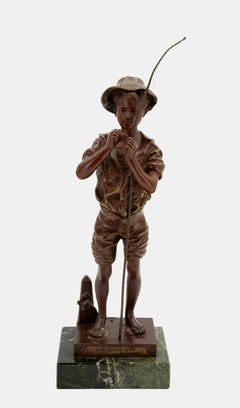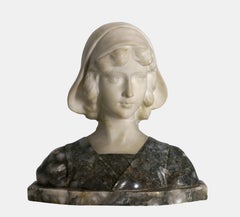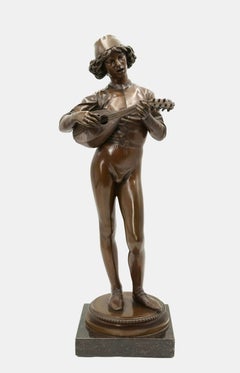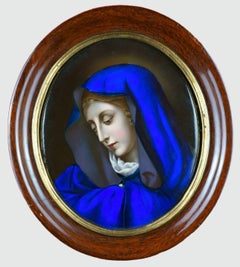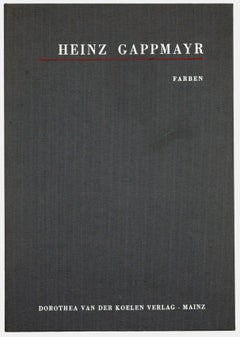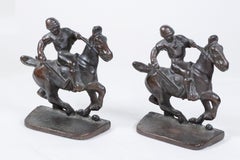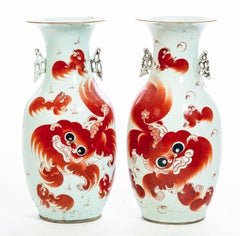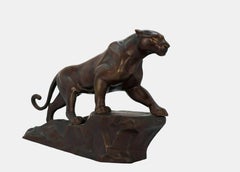Berlin - More Art
to
9
7
2
2
1
Overall Width
to
Overall Height
to
4
7
1
1
3
1
2
1
1
1
7
1
1
4
3
3
2
1
1
1
1
1
1
5
3
3
2
2
1
1
1
9,009
3,875
Item Ships From: Berlin
Pecheur / - Full of anticipation -
Located in Berlin, DE
Adolphe Jean Lavergne (1863-1928), Pecheur, c. 1900. Brown patinated bronze with rectangular cast plinth on a green marble base (3 cm high), total height with hinge 37 cm, width 9 cm, depth 8 cm, weight 2.9 kg, signed “Lavergne” on the plinth.
- Base with old drilling and a few oxidized areas, patina occasionally rubbed, somewhat stained in the folds.
- Full of anticipation -
This bronze is the larger, highly detailed version of the fisherman that made Parisian artist Adolphe Jean Lavergne famous. In preparation for fishing, the boy prepares his rod before heading out to sea. The attachment of the iron ring and the rope behind him suggest a quay wall and a boat moored there. However, the depiction is entirely focused on the actual action of the young fisherman: With equal skill and concentration, he bends a hook to connect it to the fishing line. The contrast with his casual clothing, the loose-fitting trousers, the open shirt with its "wild" folds, and, last but not least, the sun hat boldly perched on his neck, reinforces the impression of the attentive care with which he goes about his work. His gaze makes him appear absorbed, as if he has forgotten the world around him and yet he is visibly filled with anticipation of fishing.
GERMAN VERSION
Adolphe Jean Lavergne (1863-1928), Pecheur, um 1890. Braun patinierte Bronze mit rechteckiger gegossener Plinthe auf grünem Marmorsockel (3 cm Höhe), Gesamthöhe mit Angel 37 cm, Breite 9 cm, Tiefe 8 cm, Gewicht 2,9 kg, auf der Plinthe mit „Lavergne“ signiert.
- Sockel mit alter Bohrung und wenigen oxidierten Stellen, Patina mitunter berieben, in den Falten vereinzelt etwas fleckig.
- Voller Vorfreude -
Die Bronzefigur ist die größere äußerst detaillierte Ausführung des Fischers, mit dem der Pariser Künstler Adolphe Jean Lavergne bekannt geworden ist. In Vorbereitung auf das Fischen präpariert der Junge die Angel...
Category
1890s Realist Berlin - More Art
Materials
Bronze
$690 Sale Price
20% Off
Bust of a young woman / - Beauty of youth -
Located in Berlin, DE
Anonymous, Bust of a young woman, c. 1900, artificial marble and gray onyx marble. 37 cm (height) x 37 cm (width) x 22 cm (depth), weight 17.2 kg. Signed “GURRINI” on the reverse.
-...
Category
Early 1900s Realist Berlin - More Art
Materials
Marble
$911 Sale Price
20% Off
Florentine singer / - The Renaissance of the Renaissance -
By Paul Dubois
Located in Berlin, DE
Paul Dubois (1829 Nogent-sur-Seine - 1905 Paris), Florentine singer, 1865. Light brown patinated bronze with cast round plinth mounted on a square marble base (3.5 cm high). Total height 53 cm. Bronze dimensions: 49.5 cm (height) x 20 cm (length) x 10 cm (width), weight 5.6 kg. Inscribed on the plinth "P.[aul] DUBOIS", dated "1865", with the foundry's mark "F. BARBEDIENNE FONDEUR" and the signet "REDUCTION MECANIQUE A. COLLAS".
- Patina very occasionally darkened, lute with loss of one tuning peg, otherwise in excellent condition.
- The renaissance of the Renaissance -
The bronze is a precisely executed and masterfully cast contemporary reduction of Paul Dubois 155 cm tall masterpiece "Florentine Singer", which is exhibited in the Musée d'Orsay and for which the artist was awarded the Medal of Honor at the Paris Salon in 1865. The work acted as a beacon, and was followed by a plethora of depictions of juveniles.
Inspired by Donatello and Luca della Robbia, but also by painters such as Piero della Francesca, Benozzo Gozzoli, and Pinturicchio, the "Florentine Singer" is not an epigonal work that pays homage to a vanished era, but a successful attempt to draw vitality from the art of the past and thus give it new life.
The effect of vitality is the core of Italian Renaissance art theory. In order to fulfill itself as art, art had to appear like nature. This naturalism also characterizes the "Florentine Singer". The young man appears to have been taken from life, which is reinforced by the momentary nature of his action. He has just struck a now fading chord. In addition, the natural appearance is enhanced by the detailed shaping of the figurative details, such as the laces with the slightly curved leather of the shoes, the belt buckle, or the ornamentation on the body of the lute. Even the fingernails are clearly defined. Unlike the Renaissance, however, the effect of liveliness here is not based on the "discovery" of nature and the human body, but primarily on the rediscovery of the art of the Quattrocento. The liveliness of the artwork is therefore at the same time a revitalization of this art, so that we can speak of a Renaissance of the Renaissance, just as the Pre-Raphaelites in England at the same time transferred the Quattrocento to contemporary art.
Dubois takes on the most difficult of all subjects, the depiction of singing through silent sculpture. He was preceded in this by Luca della Robbia and Donatello with their pulpits of singers created in the 1430s in the Museo dell'Opera del Duomo in Florence. Compared to these works, the physiognomy of Dubois singer is far less animated, yet he also depicts singing in a convincing manner. He uses the whole body. He takes the ancient contrapposto, which was essential to Renaissance sculpture, and transforms the standing leg-playing posture into a late medieval S-swing, giving the body an elegant beauty and at the same time setting it in melodic motion. In the equally elegant finger position, the music is expressed in a much more literal way with the beating of the lute. Finally, the musicality of the sculpture culminates in the face with the mouth open to sing.
Through the act of singing, which is a great challenge to the artistic will to depict perfect beauty, the gracefulness of the classical face is not diminished, but enhanced. Starting from the face with the singing mouth and the gaze absorbed by the sounds, the inner vitality spreads, giving the bronze sculpture an intense aura, enhanced by the music. Dubois transfers the beauty of the Renaissance to the musical, sublimating the visible sculpture to the invisible of music.
He took up the challenge of transcending the Renaissance with the Renaissance, thus responding to the Querelle des Anciens et des Modernes, which arose at the end of the 17th century around the French Academy and remained virulent into the 19th century, in which antiquity was regarded either as an unattainable ideal or as a standard to be surpassed. With his work, Dubois proved that the Renaissance, which had championed the art of the ancients, could lead to a new renaissance of art.
About the artist
Paul Dubois' great-uncle was the famous French Baroque sculptor Jean-Baptiste Pigalle, in whose footsteps the talented great-nephew followed. When he debuted at the Paris Salon in 1858, he signed his work "Dubois-Pigalle". At his father's request, however, he first studied law before devoting himself to sculpture under the tutelage of François Christophe Armand Toussaint in 1856 and entering the École des Beaux-Arts in 1858. From 1859 to 1863, he lived in Rome and traveled to Naples and Florence. Inspired by Florentine art of the quattrocento, Dubois initiated a school-forming neo-Florentine style that combined the elegantly simple forms of youthful grace with a precise wealth of detail.Two purchases by the French state (“envois de Rome”) were made during his stay in Rome, which brought him recognition in Paris. After his return there, he quickly became an internationally sought-after artist.
Dubois was also active as a creator of monuments. His most famous work is the equestrian statue of Joan of Arc (1896) on the forecourt of Reims Cathedral. He was also a sought-after portraitist who produced around 50 busts and - Dubois was also a passionate painter - around 100 portraits in oil.
From 1873 to 1878 he was curator of the Museum du Luxembourg, in 1876 he became a member of the Institut de France and from 1878 to 1905 he was director of the École des Beaux-Arts.
In 1865, Dubois was awarded the Paris Salon Medal of Honor for his “Florentine Singer”. In 1867 he became Chevalier, in 1874 Officier, in 1886 Commandeur of the Légion d'honneur, which awarded Dubois the Grande Croix in 1896.
Selected Bibliography
Stole, Elmar: Paul Dubois. In: Saur. Allgemeines Künstlerlexikon, vol. 30, Munich - Leipzig 2001, pp. 677-678.
GERMAN VERSION
Paul Dubois (1829 Nogent-sur-Seine - 1905 Paris), Florentinischer Sänger, 1865. Hellbraun patinierte Bronze mit gegossener runder Plinthe auf quadratischem Marmorsockel montiert (3,5 cm Höhe). Gesamthöhe 53 cm. Maße der Bronze: 49,5 cm (Höhe) x 20 cm (Länge) x 10 cm (Breite), Gewicht 5,6 kg. Auf der Plinthe mit „P.[aul] DUBOIS“ bezeichnet, auf „1865“ datiert, mit dem Gießereistempel „F. BARBEDIENNE FONDEUR“ und dem Signet „REDUCTION MECANIQUE A. COLLAS“ versehen.
- Patina sehr vereinzelt nachgedunkelt, Laute mit Verlust eines Stimmwirbels, ansonsten ausgezeichnet erhalten.
- Die Renaissance...
Category
1860s Realist Berlin - More Art
Materials
Bronze
$4,315 Sale Price
20% Off
Madonna del Dito - Heavenly beauty down to the fingertip -
Located in Berlin, DE
KPM, Madonna del Dito, oval, slightly curved porcelain picture plate by KPM Berlin in fine polychrome onglaze painting, 27 x 22 cm (plate size), 33 x 28.5 cm (frame), unsigned, press...
Category
1880s Academic Berlin - More Art
Materials
Porcelain, Oil
$3,644 Sale Price
20% Off
SOUND AND VISION – Song for Tamlyn by Doris Marten - Installation, pink
By Doris Marten
Located in Paris, FR
SOUND AND VISION – Song for Tamlyn is a unique oil on vinyl installation by German contemporary artist Doris Marten, dimensions are 65 × 65 cm (25.6 × 25.6 in). Every piece is 30 cm ...
Category
2010s Contemporary Berlin - More Art
Materials
Oil
Colors / - The Pictures of Concepts -
Located in Berlin, DE
Heinz Gappmayr (1925 Innsbruck - 2010 ibid), Colors, 1993. Linen box with ten aquatint etchings on handmade paper and two text sheets. Published by Dorothea van der Koelen, Mainz. Co...
Category
1990s Minimalist Berlin - More Art
Materials
Paper
Kunsttöpferei Kandern, Thrown vase with double gradient glaze / - Flowering vase
Located in Berlin, DE
Kunsttöpferei Kandern (1897-1927), Thrown vase with two layers of glaze, between 1914 and 1927, terracotta, marked 'KTK' on the underside and marked as model number '781', 19 cm (hei...
Category
1920s Art Nouveau Berlin - More Art
Materials
Terracotta
KPM View cup with the Altes Museum, c. 1830 / - The birth of the Spree-Athens -
Located in Berlin, DE
Königliche Porzellan-Manufaktur (KPM), View cup with Berlin veduta of the Altes Museum, circa 1830. Bell-shaped cup with raised handle ending in a shell palmette. The front with gold...
Category
1830s Realist Berlin - More Art
Materials
Porcelain
Kunsttöpferei Kandern, Bulbous vase with gradient glaze / - Inner abundance -
Located in Berlin, DE
Kunsttöpferei Kandern (1897-1927), Bulbous vase with clay-colored gradient glaze on a black-blue ground, between 1914 and 1927. Terracotta, marked 'KTK' on the underside and identifi...
Category
1920s Art Nouveau Berlin - More Art
Materials
Terracotta
$268 Sale Price
20% Off
Kunsttöpferei Kandern, Bulbous vase with gradient glaze / - Inner abundance -
Located in Berlin, DE
Kunsttöpferei Kandern (1897-1927), Bulbous vase with clay-colored gradient glaze on a black-blue ground, between 1914 and 1927. Terracotta, marked 'KTK' on the underside and identifi...
Category
1920s Art Nouveau Berlin - More Art
Materials
Terracotta
$278 Sale Price
20% Off
White Mask on Violet Ground - Mythic mask mountain -
Located in Berlin, DE
Hermann Schütte (1893 Osnabrück - 1973 Hamburg), White Mask on Violet Ground. Enameled copper plate on wooden base, 37 x 29.5 cm, monogrammed and dated "S[chütte] [19]62" in the lowe...
Category
1960s Post-War Berlin - More Art
Materials
Enamel
$2,781 Sale Price
20% Off
Untitled (Keith Richards with Mick Jagger Puppet), signed and dedicated
By Sebastian Kruger
Located in Berlin, DE
Offset print of untitled painting (Keith Richards with Mick Jagger puppet), signed and dedicated by Sebastian Kruger (Krüger) as follows:
"Hello Little One! Happy Birthday..."
S. Kr...
Category
1990s Berlin - More Art
Materials
Offset
$3,836 Sale Price
20% Off
Related Items
Polo Player Bookends in Bronze
Located in Brookville, NY
Polo Bookends in bronze for the sporty library. These were purchased from the collection of a polo player on Long Island who had a beautiful library of sporting books. He also owne...
Category
1960s Academic Berlin - More Art
Materials
Bronze
Pair of Antique Hand Painted Chinese Jars With Foo Dogs and Inscriptions
Located in SANTA FE, NM
Pair of Antique Hand Painted Chinese Vases with Foo Dogs and Inscriptions
China, early 20th century
Porcelain
17 x 8 x 8 inches
Painted in iron red, these Foo Dogs or Imperial Guardian Lions are strong Feng Shui protection symbols which were traditionally placed in front of Imperial palaces, temples, and government offices. They were also a traditional symbol of family wealth and social status and were placed in front of wealthy homes.
It is widely accepted that foo dogs were created sometime after real lions...
Category
Early 20th Century Qing Berlin - More Art
Materials
Porcelain, Paint
$1,500 Sale Price
75% Off
H 17 in W 8 in D 8 in
The Guardian Angel
By Königliche Porzellan-Manufaktur (KPM)
Located in Missouri, MO
"Guardian Angel" late 19th c.
Original hand-painted KPM Porcelain
In Jewel Encrusted Frame
approx. 6 3/8 x 5 inches
Category
Late 19th Century Realist Berlin - More Art
Materials
Porcelain, Oil
Bellota 7
By María José de la Macorra
Located in Mexico City, CDMX
María José de la Macorra (México, D.F., 1964) realizó sus estudios en la Escuela de Cerámica y Porcelana de Toluca, Mokichi Okada Association,...
Category
2010s Naturalistic Berlin - More Art
Materials
Bronze
Water Lilies
By Roy Lichtenstein
Located in New York, NY
Published in 1990 by Rosenthal, Germany, Roy Lichtenstein’s, Water Lilies is an exquisite glazed porcelain charger, brilliantly colored, accompanied by signed certification. Stamp si...
Category
20th Century Pop Art Berlin - More Art
Materials
Porcelain, Screen
"Nude Sketch No. 3" early academic figure drawing by Ben Fenske, unframed
By Ben Fenske
Located in Sag Harbor, NY
An academic drawing of a female nude figure sitting atop a flat surface. He highlights the body with white chalk. She leans on one arm and the other rests behind her torso.
Artist B...
Category
21st Century and Contemporary Academic Berlin - More Art
Materials
Paper, Charcoal
Moonlight Ripples over Lake Como, Nautical Cyanotype Triptych of Moving Water
By Kind of Cyan
Located in Barcelona, ES
This series of cyanotype triptychs showcases the beauty of nature scenes, including stunning beaches and oceans, as well as the intricate textures of water, forests, and skies. These...
Category
2010s Minimalist Berlin - More Art
Materials
Photographic Film, Watercolor, Photographic Paper, Lithograph, Monotype,...
$880
H 39.38 in W 82.68 in
Life Size Sculpture of Male Head in Patina Bronze "Diadji"
By William J Rushton
Located in New York, NY
Bronze life-size male head with a dark brown patina. Sculpted in Florence Italy and casted in bronze just outside of the city. This is an earlier piece that holds a distinctly differ...
Category
2010s Realist Berlin - More Art
Materials
Bronze
$6,000
H 15 in W 8.5 in D 9 in
When you go with the flow, 100x100cm, acrylic, oil, canvas
By Tatiana Levchenko
Located in Yerevan, AM
When you go with the flow
Category
2010s Contemporary Berlin - More Art
Materials
Canvas, Oil, Acrylic
$1,500 Sale Price
25% Off
H 39.38 in W 39.38 in
Blue Beaded Bracelet, Modern Shapes Monotype, Minimal Layers, Watercolor Paper
By Kind of Cyan
Located in Barcelona, ES
This is an exclusive handprinted unique cyanotype that takes its inspiration from the mid-century modern shapes.
It's made by layering paper cutouts and different exposures using uv-light.
Details:
+ Title: Blue Beaded Bracelet...
Category
2010s Minimalist Berlin - More Art
Materials
Emulsion, Watercolor, Monotype, Paper
"Cowrie Shell" (2024) By Tony Hochstetler, Original Bronze Sculpture
Located in Denver, CO
Tony Hochstetler's "Cowrie Shell" (2015) is an original handmade bronze sculpture that depicts the shell of a cowrie.
TONY HOCHSTETLER is a sculptor of unusual animals and botanical...
Category
2010s Realist Berlin - More Art
Materials
Bronze
$450
H 1.75 in W 3.5 in D 2.25 in
VALTON Charles. The Griffin Marco. Patinated bronze. Marble base. Signed.
By Charles Valton
Located in Paris, FR
The Griffin Marco. Patinated bronze. Marble base. Signed and titled.
Charles Valton was a French sculptor known for his works created in the animalier style, a 19th-century movement ...
Category
Late 19th Century Realist Berlin - More Art
Materials
Bronze
$4,211
H 13.39 in Dm 16.93 in
Previously Available Items
Panther striding upwards / - The powerful elegance of animalism -
Located in Berlin, DE
Arthur Dupagne (1895 Liège - 1961 Woluwe-Saint-Pierre), Panther striding upwards, c. 1938. Patinated bronze in full cast on a hollow-cast terrain base, signed in the cast “Dupagne”, 22 cm (length) x 13.5 cm (height) x 6 cm (width), 1.35 kg.
- Patina somewhat rubbed, slightly bumped in places, in good overall condition.
- The powerful elegance of animalism -
The powerful panther strides up a rock formation and pauses at the edge, overhanging it with his left paw to peer into the distance. He seems to be surveying his territory and searching for prey at the same time. Even if the predator pauses, the impulse to move upward may continue with a mighty leap the next moment; after all, the panther seems to have already caught the scent and made visual contact.
The staircase-like rock formation shows the panther's strength, which is present down to the tip of its tail, in the elegance of its supple, powerful movement. Arthur Dupagne certainly studied these movements in nature, and yet he formulates the musculature in the geometricized language of Art Deco. This does not transform the panther into an abstract creature of art, but rather expresses the fullness of power and the exciting dynamics of its inner movement. Dupagne also transferred the artistic experience he had gained in the Congo of a powerful, original African art...
Category
1930s Art Deco Berlin - More Art
Materials
Bronze
H 5.32 in W 8.67 in D 2.37 in
Recently Viewed
View AllMore Ways To Browse
Luca Cambiaso
Manhattan Skyline Oil Painting
Manila Painting
March Avery
Martha Bloom
Marvin Lipofsky Glass
Mary Deneale Morgan
Maurice Cloud
Maurice Logan
Michael West Paintings
Michel Moreau
Miranda Boulton
Moonlit Waves
Mount Diablo
Mountain Painting With Horse
Muted Seascape
Neo Classical Painting Landscape
Nicholas Wyeth
